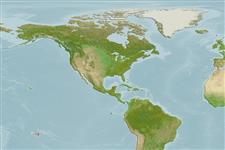Classificação / Names
Nomes comuns | Sinônimos | Catalog of Fishes(Gênero, Espécies) | ITIS | CoL | WoRMS | Cloffa
>
Kurtiformes (Nurseryfishes, cardinalfishes.) >
Apogonidae (Cardinalfishes) > Apogoninae
Etymology: Siphamia: A Swazi word, siphama, for a fish; randalli: This species is named randalli in honour of Dr. John E. Randall of Honolulu, Hawai’i, for his numerous and noteworthy contributions to our knowledge of reef fish taxonomy. Jack, as he is known to friends and colleagues, is a genuine inspiration to everyone in the field of ichthyology. Moreover, Dr. Randall’s Siphamia collections at BPBM and specimen photographs, including this species, have formed an essential part of our revision (Ref. 90035).
Eponymy: Dr John ‘Jack’ Ernest Randall Jr. [...] (Ref. 128868), visit book page.
Environment: milieu / climate zone / depth range / distribution range
Ecologia
marinhas bentopelágico; intervalo de profundidade 0 - 30 m (Ref. 90035). Tropical; 15°S - 21°S, 159°W - 149°W
Pacific Ocean: French Polynesia and Cook Islands (Ref. 90035).
Tamanho / Peso / Idade
Maturity: Lm ? range ? - ? cm
Max length : 2.9 cm SL macho/indeterminado; (Ref. 90035)
Descrição suscinta
Chaves de identificação | Morfologia | Morfometria
wDorsal rays VII+I,9; anal rays II,8; pectoral rays 14-15; tubed lateral-line scales 9-12; median predorsal scales 3-5; total gill rakers 2-4 + 10-12 = 13-16; developed gill rakers 1-2 + 9-11 =10-12; gill rakers on ceratobranchial 8 (rarely 9). Body depth 2.45-3.0 in SL and body width 1.7-2.15 in the depth; eye diameter 2.9-3.3 in head length; first dorsal spine 2.1-3.8 in second spine; second dorsal spine 4.4-6.4, spine of second dorsal fin 4.0-4.5, and second anal spine 4.7-5.6, all in head length; pectoral-fin length 4.1-4.6 and pelvic-fin length 3.8-4.4 in SL; caudal-peduncle length 1.2-1.9 in distance between pelvic spine insertion and anal-fin origin; light organ 1.65-2.7 in caudal peduncle length. Preopercular edge with 19-25 small serrations; preopercular ridge smooth. Tip of light organ on each side of tongue bound by membrane. (Ref. 90035).
Ciclo de vida ou comportamento de acasalamento
Maturidade | Reprodução | Desova | Ovos | Fecundidade | Larvas
Gon, O. and G.R. Allen, 2012. Revision of the Indo-Pacific cardinalfish genus Siphamia (Perciformes: Apogonidae). Zootaxa 3294:1-84. (Ref. 90035)
Status na Lista Vermelha da UICN (Ref. 130435: Version 2024-2)
Ameaça para os humanos
Harmless
Uso pelos humanos
Ferramentas
Relatórios especiais
Baixar XML
Fontes da internet
Estimates based on models
Preferred temperature (Ref.
123201): 27.5 - 27.9, mean 27.8 °C (based on 16 cells).
Índice de diversidade filogenética (Ref.
82804): PD
50 = 0.5000 [Uniqueness, from 0.5 = low to 2.0 = high].
Bayesian length-weight: a=0.01445 (0.00680 - 0.03071), b=3.07 (2.89 - 3.25), in cm total length, based on LWR estimates for this (Sub)family-body shape (Ref.
93245).
Nível Trófico (Ref.
69278): 3.2 ±0.4 se; based on size and trophs of closest relatives
Fishing Vulnerability (Ref.
59153): Low vulnerability (10 of 100).
